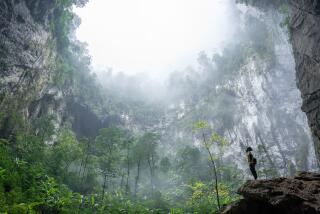TV REVIEW : PBS ‘EARTH’ SERIES OFF TO AN EARTHSHAKING START
- Share via
Most of us take this old planet of ours for granted. Only when rocked by an earthquake or a volcanic eruption do we get a sense of what geologists now know: that Earth is a “living machine,” with awesome forces at work that continually alter the surface.
What these forces are, how they exert themselves and other information that scientists have gleaned about our home in the universe are the subjects of “Planet Earth,” a new seven-part series on PBS. It debuts tonight at 8 on Channel 50 and at 9 on Channel 15, and starts Thursday at 8 p.m. on Channel 28.
Four years in the works, with footage that spans all seven continents and reaches from the depths of the ocean floor to the heights of outer space, the series was produced by station WQED in Pittsburgh, in association with the National Academy of Sciences, as the centerpiece for a college-credit geoscience telecourse. It covers not only the Earth’s structure but also its oceans, its climate, its resources, its relation to other planets and its ultimate fate at the hands of humans.
Accordingly, the approach is serious, but not dry. On the contrary, television is able to give life to the subject that no textbook could. The opening installment alone takes viewers from the Grand Canyon to a Hawaiian volcano and uses computer graphics to show how the seven continents were once a single land mass, broke apart and continue to drift across the planet.
The program makes clear that scientists don’t have all the answers yet about how our incredible “living machine” works, but it certainly makes their on-going attempts to find them look challenging, interesting and worthwhile. Richard Kiley is the narrator.
More to Read
The complete guide to home viewing
Get Screen Gab for everything about the TV shows and streaming movies everyone’s talking about.
You may occasionally receive promotional content from the Los Angeles Times.






